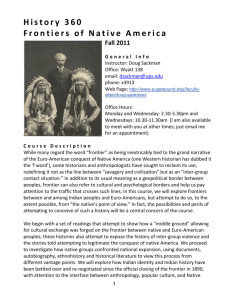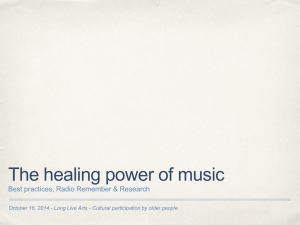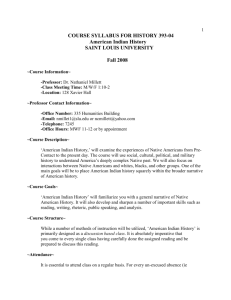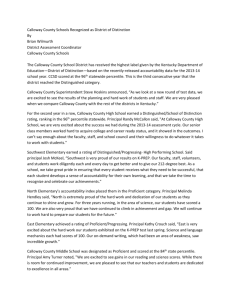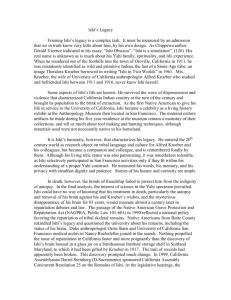360Syllabusfall09 - University of Puget Sound
advertisement
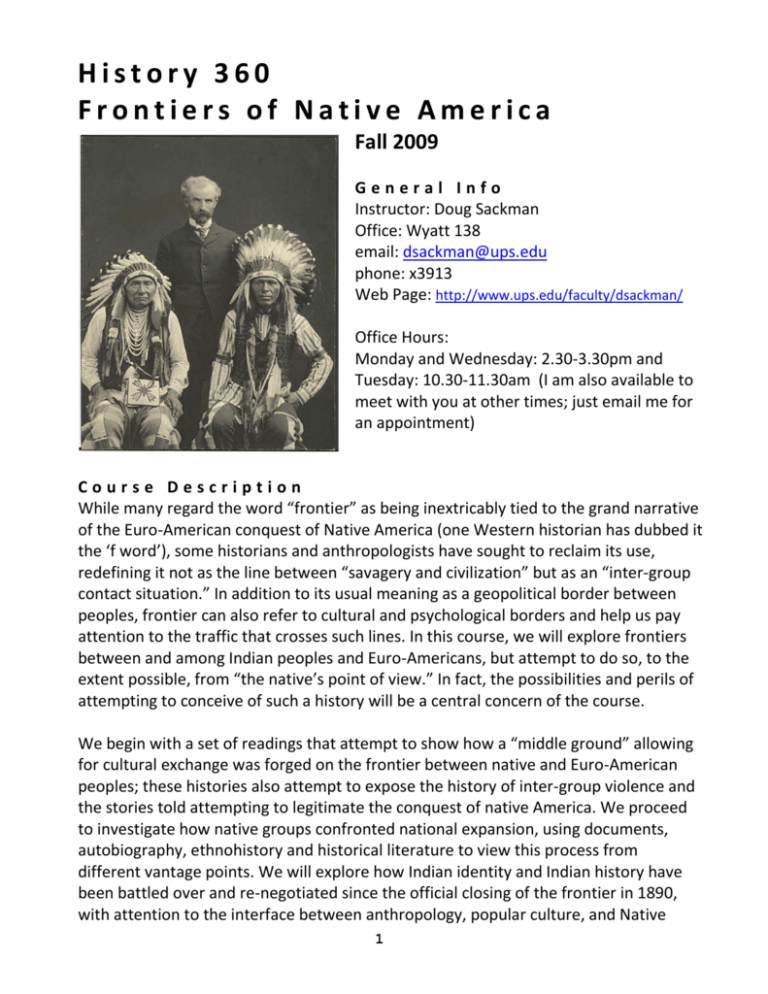
History 360 Frontiers of Native America Fall 2009 General Info Instructor: Doug Sackman Office: Wyatt 138 email: dsackman@ups.edu phone: x3913 Web Page: http://www.ups.edu/faculty/dsackman/ Office Hours: Monday and Wednesday: 2.30-3.30pm and Tuesday: 10.30-11.30am (I am also available to meet with you at other times; just email me for an appointment) Course Description While many regard the word “frontier” as being inextricably tied to the grand narrative of the Euro-American conquest of Native America (one Western historian has dubbed it the ‘f word’), some historians and anthropologists have sought to reclaim its use, redefining it not as the line between “savagery and civilization” but as an “inter-group contact situation.” In addition to its usual meaning as a geopolitical border between peoples, frontier can also refer to cultural and psychological borders and help us pay attention to the traffic that crosses such lines. In this course, we will explore frontiers between and among Indian peoples and Euro-Americans, but attempt to do so, to the extent possible, from “the native’s point of view.” In fact, the possibilities and perils of attempting to conceive of such a history will be a central concern of the course. We begin with a set of readings that attempt to show how a “middle ground” allowing for cultural exchange was forged on the frontier between native and Euro-American peoples; these histories also attempt to expose the history of inter-group violence and the stories told attempting to legitimate the conquest of native America. We proceed to investigate how native groups confronted national expansion, using documents, autobiography, ethnohistory and historical literature to view this process from different vantage points. We will explore how Indian identity and Indian history have been battled over and re-negotiated since the official closing of the frontier in 1890, with attention to the interface between anthropology, popular culture, and Native 1 Americans. We will look at the processes through which whites have constructed Indianness for their own uses, as well as the forms through which Indians have performed their own identities, told their own stories and histories in order to maintain the vitality of their cultures. While the course will involve an overview of the major events of Native American history, our approach will move beyond a simple narrative of “what happened to Indians” to a more complicated consideration of how Indians have made their own history and how that history has been presented and contested. Within the larger issue of the frontiers faced by Native Americans since European arrival in North America, the course will explore four themes: A) confluence versus conflict—the dynamics of cross-cultural contact and exchange between different native peoples and newcomers/intruders in specific places and times, as well as the forces and conditions out of which violence erupted and was sustained. B) U.S. colonialism versus Indian resistance and agency in sustaining cultures and ecologies—how native peoples confronted an expansionist and powerful nation, including consideration of various strategies of resistance and accommodation and the struggle to maintain or reestablish a sense of identity, autonomy and sovereignty. Explores what Native American examples reveal about the connection between cultural sustainability and ecological sustainability. C) the nature and politics of history—what counts as history, why, and how are issues of power and colonialism bound up with the way people (native and non-native) have represented Indian peoples, their pasts and their futures. Format and Objectives In the above description, I have emphasized what “we” will do. I mean that: the course is meant to be a collaborative investigation. Class time will be devoted largely to discussions of the readings and the issues they touch upon. I’ve designed the course to give you a range of opportunities to participate in the class and contribute to its course. Of course, you are encouraged to actively engage with discussions, raising questions, making points and otherwise contributing to the flow of the conversation. Note that the reading load for this course is heavy and in some cases involves material that is quite dense. The readings for the course are extensive, and essential. Your reactions to the content, ideas and evidence presented in the reading will be crucial to what we do in class. Doing the reading in time for class is thus critical to the success of the course. In reading selections, you will find it useful to take notes and write down particular questions you might have or topics you would like to discuss. As a student, I found that 2 underlining or highlighting passages, while helpful, was not the best way to prepare me to participate in class discussions. I started to take notes on a separate sheet of paper (or on my computer), listing the relevant page number on the left and then some idea or quote that I found interesting next to it. In class, then, I could use this as an index of my ideas, and then point to a particular passage as a basis for a question or to present my perspective on a particular issue. You may find that developing a note-taking system will work for you. Please bring the readings to class on the day for which they are assigned. If you do not do the readings, you will get little out of the class. If you do the readings, but have nothing to say about them, then the class as a whole will suffer. The more you get involved, the more you will get out of the class, and the more exciting, engaging, and successful the class will be as whole. Ideally, students in this course: • Will gain a basic knowledge of the major forces shaping Indian interactions with others from the 1490s to the Present • Will learn to see Indians as actors shaping their own history as well as American history more broadly • Will learn to use the notion of the frontier as a contact zone to appreciate crosscultural influences and negotiations • Will learn to see and analyze events from more than one perspective • Will gain an understanding of the different methods used to explore Indian history and identity • Will be able to compare and analyze different forms of history, including scholarly monographs, oral tradition, film, and fiction • Will deepen their understanding of the politics of history • Will develop their skills of oral and written expression, including formulating a position on an open-ended topic and making effective use evidence to support that position • Will develop their sense of how to ask questions about the past and the ability to propose and evaluate different interpretations of events and documents • Will see how the connection between cultural diversity and ecological sustainability are made clear through the experiences of Native peoples Readings • Colin Calloway, First Peoples: A Documentary Survey of American Indian History • Greg Sarris, Mabel McKay: Weaving the Dream • Daniel Richter, Facing East from Indian Country: A Native History of Early America • James Welch, Fools Crow • Orin Starn, Ishi’s Brain: In Search of America’s Last “Wild” Indian • Coll Thrush, Native Seattle • History 360 Reader 3 Course Requirements 1) Participation and short papers (28%) This category includes reading, attendance & participation in discussions. Regular attendance is expected. Students can participate in class by making points and connections, raising questions, listening and responding to the comments of other students, and otherwise engaging with the flow of the discussion. Informal writing assignments, which will not be given a letter grade but will be assigned a number from 0-4 that assesses their general quality, include 5 1-2-page Discussion Papers, 1 film review paper, 2 document gathering/historical news report assignments, and informal writing in class. A variety of other short assignments for class preparation may also be required. Active listening and asking questions and making comments are integral parts of class participation. 2) A 10-minute Class Presentation on a topic of the student’s choice (5%) 3) Interpretive essay I: a 4-6 page paper due in Week 6 (21%) 4) Interpretive essay II: a 4-6 page paper, due in Week 11 (21%) 5) Final Project: a research essay: A 7-10 page paper on a topic relevant to the course, making use of both primary and secondary sources. You may wish to consult with me about ideas for the paper. The final project is due Thursday of Finals Week (25%) Note on Quiz Possibilities: depending on the quality of class discussions and the collective sense of how thoroughly and completely the reading is being done, we may need to add quizzes or other assignments to the course itinerary (in which case, the percentage weight of some of the above categories will be reduced to make room for the quizzes, etc). Grading Policies The work in all of the above categories will be taken into account to determine your final grade. In general, the writing asks you to go far beyond the recitation of facts and information. You will be formulating your own ideas and arguments, gathering and organizing evidence to support your positions, and putting it all together in finished essays that are at their best polished, engaging, original, creative, and/or provocative. I will distribute more specific criteria that I use in evaluating your longer papers. The Prep Papers are more informal in orientation, and one of their purposes is to allow you to pursue your ideas and hone your writing talents without the pressure of grades. The following statements will give you some idea what level of work and participation constitutes what kind of grade in this course: 4 Work that is of D-level or below does not rise to the standards of expectations in the class, which are reflected in the description of C-level work. C-level work is considered both average and respectable in this course. Work that merits a C represents a serious engagement with the class and the course materials by the student. For papers, this means that the paper deals with its topic, makes use of the proper number and type of sources, shows that the student has grappled with the readings and issues, and advances a central idea or thesis. Yet, the thesis may be vague and there may be problems with the mechanics, organization or clarity of the paper. In terms of participation, the C-level student regularly attends, is attentive to what is going on in the classroom, occasionally offers ideas and perspectives in class, completes the Prep Papers in satisfactory fashion, and willingly contributes to small group discussions. B-level work is very good. It represents both serious engagement with and reasonable mastery of the course material. The B-level student maintains their degree of engagement throughout the course, and usually their work shows improvement. Papers that merit a B are well-crafted and organized, advance a central thesis that addresses the paper’s topic in an interesting or illuminating fashion, are mostly free from mechanical and grammatical errors, draw effectively on a range of materials, and are generally persuasive and cogent in their argument. B-level participation involves regular attendance and participation in class discussions. Comments and contributions are often based on a careful consideration of the readings. For example, such a student may sometimes point to a specific passage in the text to back up or develop their comment or question. A-level work is exceptional. Not only do A-level papers display all of the good qualities of a B-paper, their central argument is advanced with an exceptionally impressive degree of sophistication, originality or insight. The paper's organization, craft and use of evidence are all excellent. In terms of participation, contributions to class discussions are both frequent and particularly insightful. Late Policy: Assignments that are up to 24 hours late will receive a 1/3 grade reduction (e.g. a B would become a B-); assignments turned in more than one but less than two days late will be lowered 2/3 of a grade; work turned in three days late will be lowered a full grade; work turned in beyond three-days late will be lowered a 1 and 1/3rd grade. Academic Honesty Faith in your academic integrity is vital to all we do at UPS. It should go without saying that the college expects that all work submitted for evaluation in courses will be the product of the student's own labor and imagination. Of course, you are free to speak 5 with others about your work and share ideas and perspectives. In writing your papers, though, you are developing your own ideas and arguments. You can incorporate the ideas or words of others in your own paper, but to do so you must properly cite your sources. Turning in a paper that attempts to pass off the words or ideas of others as your own constitutes plagiarism (see The Logger for more information). Like other forms of cheating, plagiarism is a contamination that pollutes our environment. Students who knowingly turn in work that involves plagiarism or is marred by other forms of cheating will not pass the course, though more severe penalties may be recommended for egregious cases. One can understand the temptation to turn in illegitimate work: students working under intense pressures may turn to cheating as an easy way out. But to do so, you not only steal the work of others, you cheat yourself and your fellow students as well. A real degree from UPS cannot be obtained through looting. If you are worried about your grade or completing an assignment, please come and talk to me. I can work with you to help you get over the hurdles and make it possible for you to get something positive out of the course. Discussion Papers The class is divided into “groups”—A, B. C and D (This is basically for the purpose of dividing up the class—you will be writing your discussion papers individually, not in groups). Discussion Papers for your group are due on the days indicated in the course schedule with your groups letter in brackets next to the date (see below). Under no circumstances, including computer failure, may Discussion Papers be turned in late, since their purpose is to be available for use in the class discussion on the day on which they are due. (In certain circumstances, I may allow you to switch the day for which you write a discussion paper, but you must ask me about this at least 24-hours in advance). Discussion Papers should be typed and between 1 and 2 pages long. The Discussion Papers involve two components: a topic discussion and an issue identification: Topic Discussion: For the topic discussion, I would like you to write 2-3 paragraphs or so about some aspect of the reading for that day that grabs your attention and you would like to discuss. I am not looking for you to summarize the reading. Instead, I would like you to identify some theme or issue raised in the reading and interpret its significance. You need not deal with the reading as a whole; in fact, you may want to focus on a small part of the larger reading. You may wish to draw comparisons between the readings of the day, or between the reading of the day and previous readings. You may wish to discuss how the reading relates to some larger issue in the class. You must include at least one quotation from the reading in your paper (normally, stronger papers use such 6 citations). Please provide the page number in a footnote or in parentheses for your quotations. I will on occasion ask you to summarize or read your topic discussion for the class. Issue ID: The second component of the Discussion Paper is the identification of some issue that can be suitable for class discussion. This can be one or two sentences long, and it can be as simple as identifying a quote from one of the readings that you find illuminating and interesting or questionable and briefly stating what important issue you see in the quote. You might also raise a point of comparison between readings. The issue may be related to your topic discussion, though it need not be. Be prepared with these: I will on occasion ask you to present your issue id in class as a way to start discussion. Presentations Presentations should be no more than 10 minutes long, but the format for the presentation is up to you. However you decide to present your findings, the best presentations are well-organized, rehearsed, informative, interesting, and engaging. They at once do a good job of presenting information in an interesting manner and conveying a few larger points or conclusions about the topic. While your presentations no doubt will be informative, we will also be interested in your interpretations. Thus, you might want to consider these kinds of questions: What significance do you see in your topic? How does it relate to other aspects of Native American history we’ve looked at in the class? Does it tell us something about the “frontier” between Indians and whites; does it speak to how issues of identity, power, or survival were negotiated or fought over? On the day of your presentation, please also turn in an annotated bibliography of at least three sources consulted (at least one of which should not be a web-based source, that is, a scholarly book or article; for books, use Simon or Summit; to find articles, use the database America: History and Life). The annotation can simply be 24 sentences describing the source and the way it is useful. You may wish to ask me for ideas for sources. [This should give you some idea of the grading criteria: a presentation that is researched adequately, is informative, and is organized effectively is roughly a B-/B; presentations that manage to be engaging and are especially interesting in their interpretations and/or imaginative and creative in their presentation move up higher on the scale; presentations that are less well-organized, poorly presented, drag on beyond the time allotted, and/or are not very informative move down on the scale.] Historical News Reports On two occasions, you will be assigned to gather an historical document related to the course readings or themes. 7 For this historical news report, I am asking you to locate a newspaper or magazine article from the period we are reading about or that is topically related in some way. Then, write a paragraph about what significance you find in the article, and/or how it relates to the reading or course themes. Please bring a copy of the article and your paragraph to class. There are somewhat more specific parameters listed in the course schedule itself when your group has a historical news report due. Below are listed several online full-text databases where newspaper or magazine articles from the mid-19th century through the 20th century can be found. Experiment with different search terms and setting the date parameters in different ways (e.g., you could focus on a particular year or decade) until you find an article of interest. ProQuest Historical Newspapers - (Click on "clear all databases," then scroll to the bottom to the Historical Newspapers section and select the Historical New York Times (run begins in 1851), Wall Street Journal, or Christian Science Monitor, and Los Angeles Times. The New York Times goes back the furthest. Full text and full image available. You can get to this through the "Proquest Newspapers" entry in the library's Database index: http://www.ups.edu/x9763.xml Making of America - Digital library of primary sources in American social history from the antebellum period through reconstruction. Provides full-text access to several nineteenth-century periodicals. [Cornell University] http://cdl.library.cornell.edu/moa/ The Nation Digital Archive - [Scroll down; Ebsco has alphabetized The Nation under the letter "t" instead of "n."] Foreign affairs, local and national politics, education and law, 1865-1999 (full text, full image). You can find this under "N" through the Library's Digital Database index: http://www.ups.edu/x9763.xml 8 COURSE OUTLINE Note: All readings from the History 360 Reader are designated by a number; those from the books are bulleted. Readings are to be completed before class on the day designated. The letter in bracket designates a group name; members of that group have Discussion Papers due that day. Part I The Politics of Indian History: Who controls the stories, and how are they told? Week 1: The Metanarrative of Indian History: Stereotypes & History Tu (9/1): Introduction Th (9/3): Frontiers of Historical Imagination [Groups A and B: normally, you are free to choose whatever aspect of the reading you wish for your topic discussion and issue id, but for the first session I would like those in Group A to pose an Issue ID related to the Calloway, Turner, and/or Cayton and Teute readings, and for those in Group B to pose an Issue ID related to the Axtell and/or Momaday readings; you are free to discuss any of the readings in your Topic Discussion] • Calloway, 1-8 1. Frederick Jackson Turner, from “The Significance of the Frontier in American History” 2. Cayton and Teute, “On the Connection of Frontiers” 3. James Axtell, “The Ethnohistory of Native America” 5. N. Scott Momaday, “Personal Reflections” Week 2: The Enduring and Surprising history of Mabel McKay Tu (9/8) [Groups C and D]: Native Identity in a Mixed World • Sarris, Mabel McKay, 1-84 Th (9/10) [A] Sustainability: Culture and Environment • Sarris, Mabel McKay, 84-end Please visit the California Indian Basketweavers Association website, and consider their self-portrayal in relation to the book and the issue of cultural and ecological sustainability: http://www.ciba.org/ Film: part of In the Light of Reverence 9 Week 3: Time, History, Myth Tu (9/15) [B] 7. Peter Nabokov, from A Forest of Time • Calloway, (intro to chapter 1 and " A Navajo Emergence Story"), pp. 12- top of page 16 and 33-43 Part II Contact & the Middle Ground, 1492-1800 Th (9/17) [C]: First Contacts • Richter, Facing East from Indian Country, 1-40. • Calloway, 16-30, 56-62. Week 4: Missions, Empires, Nations and Identity Tu (9/22) [D]: • Richter, chs. 2 & 3 • Calloway, “Two Views of King Philip,” 123-136; also, look at his “images of invasion” photoessay (137-142) Recommended: Calloway, chapter 2, 67-94 Wed Evening Screening of Black Robe, 5-7pm Th (9/24) [A] • Richter, 110-129 • Calloway, “The Jesuits in New France,” 109-121 • Calloway, 74-88 Film review paper due in class: a 1-2 page discussion of some aspect of Black Robe, in which you make at least one citation from the Jesuit missionary Jean de Brébeuf’s document in Calloway [note: two films are screened for the class, and you need to write a film review paper on one of the two] Week 5: The New Nation: Negotiating with Indians and Playing Indian Tu (9/29) [B] <Historical News Report, Group D: (You may wish to look for an article that discusses Indians as a "race"; you might search for keywords or citation/abstract words "red man" or "redskin," and consider how the term is used in the article you select; choose an article published before 1900]] • Richter, ch 6 • Calloway, 137-153 Th (10/1) [C] 10 10. Philip Deloria, “Playing Indian” • Calloway, 193-198 and 327-334 < Historical News Report, Group A (You may wish to look for an article in which Indians or Indian culture are portrayed positively, indirectly or directly, or of white Americans somehow "playing Indian" (you can use that as a search term); choose any article published before 1925] Week 6: Captivity and Removal Tu (10/6) [D] Captivity Narratives <Historical News Report, Group B (You may wish to look for an article on whites being held captive by Indians (you could entering keywords such as "white captive by Indians"), about Indians in "white" society (in cities or in boarding schools [such as Carlisle Institute or the Sherman Institute]), or an article about Indians that reflects stereotypes; choose an article published before 1910] • Calloway, Mary Jemison's account, 153-170. 9. John Jewitt, Captive Among the Nootka (Mowachaht) Part III Confronting Manifest Destiny, 1800-1890 Th (10/8) Dislocation, Invasion and the Law read: • Calloway, 172-176, 199-221; 240-249; 259-276; 290-293. But there is no class today, as I will be away at the Western History Conference Week 7: Whites enter the world of the Blackfeet Tu (10/13) [A and B] <Historical News Report, Group C; (You may wish to look for an article about the Cherokee Indians, the Blackfeet/Blackfoot Indians, about the Crow Indians, about war between Indians and whites, choose an article published before 1900]] • James Welch, Fools Crow, 1-125. Th (10/15) 13 Documents on Little Bighorn [Continue Fools Crow] <<Interpretive Essay due Friday by 5pm; turn them in to the folder next to my box, Wyatt 138>> Week 8: Visions and Massacres Tu (10/20): Fall Break Th (10/22) [C and D] 11 • James Welch, Fools Crow, 129-288 23. Barbara Cook, "A Tapestry of History and Re-imagination: Women in James Welch's Fools Crow" • Calloway, 279-281 Week 9: Enemies and "Friends", Military and Cultural Assaults Tu (10/27) [A] • Welch, 288-end 14 Patricia Limerick, “Haunted America” <<Reminder: Begin thinking about your final project>> Th (10/29) [B]: "Kill the Indian and Save the Man": Indians, Reform, Americanization, 1870s-1920s • Calloway, Chief Joseph’s “View of Indian Affairs, 314-325 15 selections from Charles Eastman 22 Black Elk, on the Ghost Dance Week 10: Of (Re)Education, Anthropologists and “Wild” Men Tu (11/3) [C] • Calloway, 367-389 • Calloway, 335-363 17 Vine Deloria, Jr., “Anthropologists and Other Friends” Part IV Indians and Anthropologists: Salvage versus Survivance, 1880s-1910s and beyond Th (11/5) [D] • Starn, Ishi’s Brain, 10-63 <Historical News Reports, group B: Search the Los Angeles Times Historical Database for articles related to Ishi or Alfred Kroeber> Week 11: Tu (11/10) [A] 12 • Starn, Ishi’s Brain, 64-117 18 Documents on Ishi <Historical News Reports, group C: Find an article about Indians of interest published between 1911 and 1916, and consider differences and similarities to Ishi's story> Th (11/12): [B] • Starn, 134-153; 174-199; 249-266 20 James Clifford, “Four Northwest Coast Museums” Part V The Northwest Case: Indians and Others in Seattle and Puget Sound, from the “First Time” to the Present Week 12 Tu (11/17) film: Smoke Signals <<Wednesday: Interpretive Essay II Due by 5pm>> Th (11/19): [C] 16 Philip Deloria, “Representation: Indian Wars, The Movie” • Calloway, 456-463. Film review paper due: a 1-2 page discussion of some aspect of Smoke Signals, in which you also make at least one citation of the Deloria article. Week 13 Tu (11/24) [D] 12 Seattle’s Speech •Thrush, Native Seattle, vii-xi; xiii-xvii, 3-16 • consult the "Atlas of Indigenous Seattle", in Thrush, 209-248. Note: TT Waterman, the anthropologist who worked with Kroeber and made the "first contact" with Ishi, did a lot of the original interviews and consultation that helped this atlas come into being. Th (11/27): Thanksgiving Week 14: Treaties, War, and Representation Tu (12/1) [A] 13 11 Treaty of Hahd-Skus/Point No Point • Thrush, 17-65 <Historical News Reports, group A: Find an article about Indians in Washington or the Northwest before 1950> Th (12/3) [B] • Thrush, 66-78; 105-161 • please consult Chinook jargon website: http://chinookjargon.home.att.net/ <Historical News Reports, group D: Find an article about Indians in Washington or the Northwest before 1950> Week 15: Sovereignty Tu (12/8): [C and D] • Thrush, 162-207 • Calloway, 414-422; 453; 510-511; (Oliphant v Suquamish decision), 514-518 • Calloway, 468-473; 484-504 <<Thursday of Finals Week: Final Paper Due by 5pm>> 14


